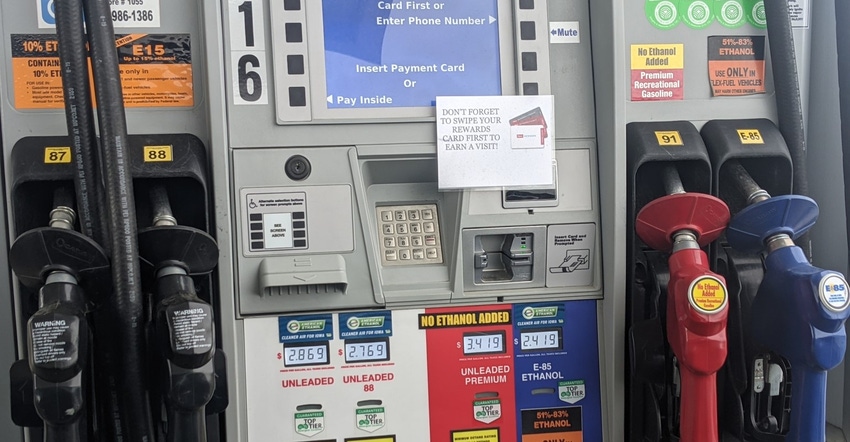
A bipartisan group of seven Midwest governors, led by Republican Iowa Governor Kim Reynolds, sent a letter to EPA Administrator Michael Regan inquiring about the steps necessary to implement a state-level solution to ensure E15 can be sold all year long.
The governors’ request guidance from Regan seeks clarification on what documentation is necessary for them to exercise their rights under the Clean Air Act to end the E10 volatility waiver in their states, thereby ensuring gasoline blendstocks could be used to produce either E10 or E15 year-round. The governors’ letter follows a D.C. Circuit Court decision earlier this year that found in favor of oil refiners and overturned EPA’s 2019 regulation that finally allowed the year-round sale of E15 in conventional gasoline markets.
“Our states lead the nation in the production of low-carbon ethanol, and we have witnessed first hand the important environmental, economic and social benefits generated by a healthy and thriving renewable fuels industry. Thus, we were extremely disappointed by the recent D.C. Circuit Court decision overturning the Environmental Protection Agency’s 2019 regulation that finally facilitated year-round sales of E15 (gasoline blended with 15% ethanol) in conventional gasoline markets,” the governors wrote.
The CAA sets a cap on fuel volatility during the summer driving season that begins June 1 of each year. Due to the recent court case brought by oil refiners, E10 continues to receive a small waiver, but E15 does not. This allows oil refiners to supply only the higher volatility gasoline that can be used to blend E10 but would not be legal to use for blending E15 without a volatility waiver.
“In the wake of the court decision, we are exploring all of our options to ensure retailers are able to sell E15 to consumers all year long without interruption…While we are not formally submitting the notification required under [the CAA] today, we do want to express our interest in potentially pursuing this approach,” the governors wrote. “We look forward to speaking with you soon about our options for protecting the substantial investments our states have made in clean fuels and ensuring consumers in our states can continue to purchase E15 all year long.”
In the letter, the governors expressed interest in pursuing an approach under the Clean Air Act to promulgate regulations that would put E10 and E15 on equal footing with regard to volatility limitations, thus re-opening the door to year-round sales of both fuels.
The Act establishes that upon the request from the governor of a state, the administrator shall apply volatility limitations to gasoline-ethanol blends that exclude the benefit of the 1-pound per square inch Reid vapor pressure waiver provided to E10, the letter states. “If approved, it is our understanding that such a request would result in a volatility limitation of 9 psi for both E10 and E15 in conventional gasoline areas, thereby establishing a level playing field and allowing retailers to use the same gasoline blendstock for both blends all year long.”
Governors signing the letter were Reynolds, Pete Ricketts, R-Neb., Tim Walz, D-Minn., Tony Evers, D-Wisc., Doug Burgum, R-N.D., Kristi Noem, R-S.D., and Mike Parson, R-Mo. In addition, Gov. Laura Kelly, D-Kan., sent a similar letter to EPA in recent weeks. This bloc of eight contiguous states consumes approximately 13 billion gallons of gasoline annually. A universal move from E10 to E15 across these states would expand ethanol consumption by nearly 700 million gallons and boost corn demand by 225 million bushels, according to the Renewable Fuels Association.
Commenting on the letter, RFA President and CEO Geoff Cooper says, “We sincerely appreciate the efforts of these governors to protect and expand market opportunities for the region’s farmers and ethanol producers. The governors should be applauded for working together to proactively seek solutions at the state level, rather than waiting for Washington to clean up yet another regulatory mess created by the oil industry. Ethanol producers and farmers stand with these governors, and we will leave no stone unturned in our pursuit of an open and competitive marketplace for E15 and other lower-cost, lower-carbon ethanol blends. We encourage EPA to expeditiously respond to the governors and open the dialog needed to remove the outdated and absurd regulatory barrier to summertime sales of E15 in these states.”
The American Coalition for Ethanol commended the actions of the bipartisan group of governors. “Given the sense of urgency to ensure uninterrupted availability of E15 year-round in all parts of the country, we are enormously grateful that these Midwest governors are deploying their influence to protect this growing clean fuel market in their states and the investments of fuel marketers, biofuel producers, USDA and state governments to expand consumer access to a low-cost, clean fuel blend, so it can continue to reduce emissions from transportation,” says Brian Jennings, ACE CEO.
Iowa Renewable Fuels Association Executive Director Monte Shaw adds, “We all hope either Congress or EPA will take action to preserve nationwide access to E15 on a year-round basis. But if no timely national solution is found, governors have the authority to implement a state-by-state solution. We heartily applaud the Midwest governors for putting oil refiners on notice that their market obstructionism will not stand. The oil refiners may have created this problem, but all 50 governors can fix it.”
About the Author(s)
You May Also Like






